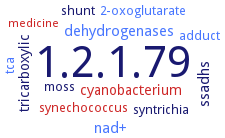1.2.1.79: succinate-semialdehyde dehydrogenase (NADP+)
This is an abbreviated version!
For detailed information about succinate-semialdehyde dehydrogenase (NADP+), go to the full flat file.

Word Map on EC 1.2.1.79 
-
1.2.1.79
-
ssadhs
-
nad+
-
dehydrogenases
-
tricarboxylic
-
cyanobacterium
-
2-oxoglutarate
-
adduct
-
moss
-
tca
-
syntrichia
-
shunt
-
synechococcus
-
medicine
- 1.2.1.79
- ssadhs
- nad+
- dehydrogenases
-
tricarboxylic
- cyanobacterium
- 2-oxoglutarate
- adduct
-
moss
- tca
-
syntrichia
-
shunt
- synechococcus
- medicine
Reaction
Synonyms
AbSSADH, ALDH21, all3556, ApSSADH, gabD, GabD1, NADP+-dependent SSADH, NADP+-dependent succinic semialdehyde dehydrogenase, NADP-dependent succinic semialdehyde dehydrogenase, PpSSALDH, slr0370, Sp2771, SpSSADH, SSADH, SSADH-II, SSALDH, SSO1842, succinic semialdehy de dehydrogenase, succinic semialdehyde dehydrogenase, SYNPCC7002_A2771, SySSADH
ECTree
Advanced search results
Crystallization
Crystallization on EC 1.2.1.79 - succinate-semialdehyde dehydrogenase (NADP+)
Please wait a moment until all data is loaded. This message will disappear when all data is loaded.
in complex with NADP+, hanging drop vapour diffusion method, using 0.2 M ammonium tartrate, 26-31% polyethylene glycol 3350, 10 mM beta-mercaptoethanol and 0.1 M Tris (pH 7.2-7.5)
to 1.4 A resolution. The overall structure of SSADH shares the general fold of ALDH classes 1 and 2. The SSADH monomer is composed of three domains; an N-terminal NAD(P)-binding domain of residues 1125, 148256, and 457472, a catalytic domain of residues 257456, and an oligomerization domain of residues 126147 and 473482. The catalytic loop of Escherichia coli SSADH, unlike that of human SSADH, does not undergo disulfide bond-mediated structural changes upon changes of environmental redox status. The protein is not regulated via redox-switch modulation. A difference in the conformation of the connecting loop beta15beta16 causes the formation of a water molecule-mediated hydrogen bond network between the connecting loop and the catalytic loop in Escherichia coli SSADH
-
comparison to human enzyme, analysis of NADP+ binding site. Enzyme is a homotetramer with the 4 monomers related by a non-crystallographic 222 symmetry. The conserved catalytic site residues and active site residues correspond to C288 and E254 as well as R164, R282 and S445, respectively
purified PpALDH21 in apoform, and in complex with succinate and NADP+, X-ray diffraction structure determination and analysis at 2.15-2.30 A resolution, structure modeling
enzyme SpSSADH in a binary complex with succinate semialdehyde as the substrate and a ternary complex with succinate semialdehyde and NADP+, hanging-drop vapor diffusion method, mixing of mixture of 0.001 ml of protein solution with 0.001 ml of reservoir solution, for the binary complex crystal, SpSSADH is pre-incubated with succinate semialdehyde at the molar ratio of 1:2, and the protein-substrate mixture is crystallized over 00.5 ml of reservoir solution containing 0.1 M sodium acetate trihydrate, pH 4.6, and 2.0 M ammonium sulfate, the trinary complex is obtained by soaking the pre-grown NADP+ co-crystallized crystal with a 1:10 molar ratio of succinate semialdehyde under the same reservoir conditions, 22°C, X-ray diffraction structure determination and analysis at 2.4 A resolution, molecular replacement method with the apo-structure of SpSSADH, PDB ID 4OGD, as the search model
structures in a binary complex with succinic semialdehyde as the substrate and a ternary complex with the substrate succinic semialdehyde and the inhibitory succinate semialdehyde, at 2.4 A resolution for both structures
structures in apo-form and in a binary complex with NADP+ at 1.6 A and 2.1 A resolutions, respectively. Both structures show dimeric conformation and contain a single cysteine residue in the catalytic loop of each subunit. Residues Ser158 and Tyr188 participate in the stabilization of the 2'-phosphate group of adenine-side ribose in NADP+
crystal structures of SySSADH determined in their apo form, as a binary complex with NADP+ and as a ternary complex with succinic semialdehyde and NADPH, resoultion of 1.7 A for the apo form and of 1.4 A for the binary and ternary complex
crystal structures of wild type Sp2771 at 2.1 A resolution, Sp2771 S419A mutant at 2.5 A resolution and ternary structure of non-catalytic Sp2771 C262A mutant in complex with NADP + and succinate semialdehyde at 1.7 A resolution
purified recombinant enzyme in apo form, in a binary complex with NADP+, and in a ternary complex with succinic semialdehyde and NADPH, sitting drop vapor diffusion method, using a crystallization buffer of 0.05 M potassium phosphate monobasic, 20% w/v PEG 8000, and 2 mM CaCl2, 22°C, for the binary and tertiary complexes, a pre-grown crystals of SySSADH are soaked for 60 min in a solution of 0.05 M potassium phosphate monobasic, 20% w/v PEG8000, 30% v/v ethylene glycol, and 50 mM NADPH or 50 mM NADPH and 50 mM succinate semialdehyde, respectively, X-ray diffraction structure determination and analysis at 1.4-1.7 A resolution, single-wavelength diffraction, modelling
purified recombinant His6-tagged wild-type Sp2771, and Sp2771 S419A and Sp2771 C262A mutants in ternary complex with NADP+ and succinate semialdehyde, mixing of 0.001 ml of protein solution and reservoir solution each, the latter containing 15% PEG 5000 MME , 1 mM DTT, 3% tascimate, and 100 mM HEPES, pH 6.8 for the wild-type enzyme and the mutants, for Sp2771 mutants in complex with NADP+ and succinate semialdehyde, NAD+ and succinate semialdehyde are incubated with proteins for 15 min at room temperature before crystallization, 20°C, 3 days, X-ray diffraction structure determination and analysis at 1.7-2.5 A resolution, molecular replacement using Escherichia coli SSADH structure, PDB ID 3JZ4, as search model


 results (
results ( results (
results ( top
top





